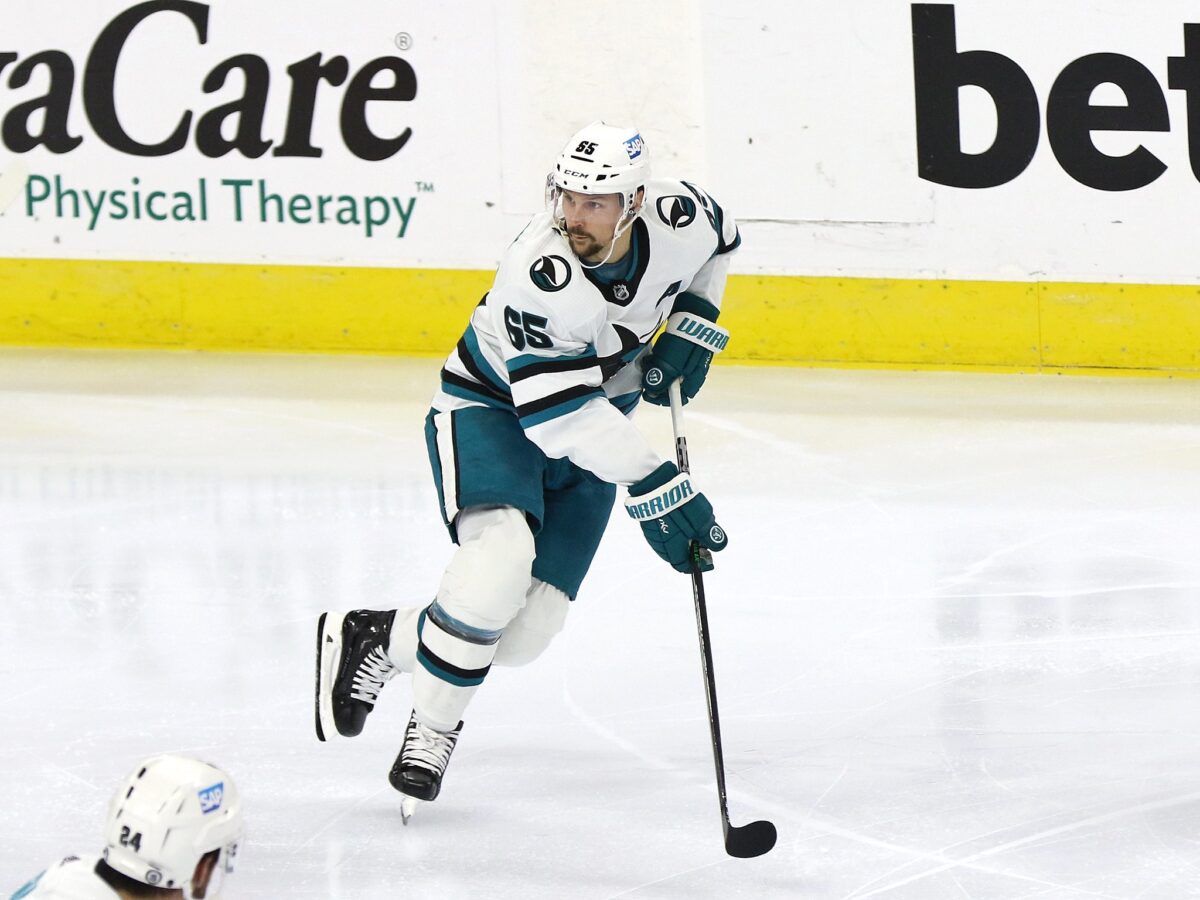During every NHL offseason, the attempt to come up with discussion topics inevitably leads to hyperbole being thrown out into the world. This is because these topics tend to be fun to talk about. One of those is whether Sidney Crosby and Evgeni Malkin can reach 100 points again this season… or should I say one final time?
In this brave and fancy new world, we have ways to examine players’ past outputs to figure out what is most likely to happen this season. We’re going to use a couple of those today, and my editor promises we’ll keep this interesting.
Time for the Stats
Starting with the traditional, here are Crosby and Malkin’s boxcar stats and points per game average over the previous three seasons:
| 2020-21 | Games | Goals | Assists | Points | Points Per Game |
| Sidney Crosby | 55 | 24 | 38 | 62 | 1.13 |
| Evgeni Malkin | 33 | 8 | 20 | 28 | 0.85 |
| 2021-22 | Games | Goals | Assists | Points | Points Per Game |
| Sidney Crosby | 69 | 31 | 53 | 84 | 1.22* |
| Evgeni Malkin | 41 | 20 | 22 | 42 | 1.02 |
| 2022-23 | Games | Goals | Assists | Points | Points Per Game |
| Sidney Crosby | 82 | 33 | 60 | 93 | 1.13 |
| Evgeni Malkin | 82 | 27 | 56 | 83 | 1.01 |
1.22 is the magic number with points per game, as at that rate, one would score 100 points in an 82-game season. In the past three seasons, only Crosby has once scored at a 100-point pace, with Malkin scoring at a point per game these past two seasons.

As the top two centers on the team, both Crosby and Malkin will be afforded plenty of ice time both at even strength and on the first power play unit.
Keeping this mainly to the past three years to look at the latest data, here is the average time on ice per game (ATOI) for Crosby and Malkin in that timeframe:
2020-21
Crosby: 20:24, Malkin: 17:44
2021-22
Crosby: 19:58, Malkin: 18:20
2022-23
Crosby: 20:09, Malkin: 18:35
The ATOI has been consistent, with each playing virtually the same amount as their previous seasons these past three seasons, with Crosby playing clear first-line minutes and Malkin playing clear second-line minutes. Malkin’s place on the top power play unit should provide more opportunity to put up points. To that end:
2022-23 Power Play Production
Crosby: nine goals, 18 assists, 27 points
Malkin: 11 goals, 25 assists, 36 points
Related: Pittsburgh Penguins Scouting Report: What to Watch for This Year
We’re only using last season for the power play as a variety of issues (pandemic, injuries) limit the value of the previous years. As I noted recently, Malkin is still an offensive wizard with as good of hands as anyone in the game. These numbers should not be a surprise and show someone who can still produce elite offense and offensive numbers. For what it’s worth, Crosby scored three fewer power play points in 13 more games than the previous season, and his power play point per game production has been largely flat over the past four. With the man advantage, he is who he is.
Points Per 60
Points/60 is a simple enough stat, tracking how many points someone scores over 60 minutes. Sometimes it’s used to illustrate the offensive prowess of bottom-six players (former Penguin Daniel Sprong was a standout last season in this regard, with 3.07 points/60 at even strength in a fourth-line role with the Seattle Kraken). Here, we will use it to see if there is any age-related drop-off in Sid and Geno’s offensive production at even strength.
Sidney Crosby
| Goals/60 | Assists/60 | Points/60 | |
| 2020-21 | 1.14 | 1.33 | 2.47 |
| 2021-22 | 1.21 | 1.64 | 2.85 |
| 2022-23 | 1.09 | 1.9 | 2.98 |
Evgeni Malkin
| Goals/60 | Assists/60 | Points/60 | |
| 2020-21 | 0.5 | 1.87 | 2.37 |
| 2021-22 | 1.11 | 1.11 | 2.21 |
| 2022-23 | 0.81 | 1.57 | 2.37 |
What’s nice to see is there seems to be no age-related drop whatsoever. Crosby’s points/60 have increased in each of the past two seasons, and Malkin’s have stayed remarkably consistent, further proof of their otherworldly work ethics and skillsets. They’re champions for a reason.

So, what does this mean? Well, as you may have heard, Connor McDavid obliterated every goalie and their children’s children last season to the tune of 153 points in 82 games. Looking at his points/60 at even strength, McDavid’s superhero cape knows no bounds, with 3.15 points/60 minutes against top checking lines and the top defensemen in the world. At the lowest end of the 100-point club last season was someone that no one in Pittsburgh has heard of, a fella by the name of Erik Karlsson. He had a 2.48 points/60 last season. From that perspective, at even strength, it’s safe to say that both Crosby and Malkin are still in range of the magic mark.
Speaking of our generation’s Paul Coffey…
The Karlsson Effect
While I initially wasn’t a huge fan of going after him, Erik Karlsson is now here, and it’s not a bad thing. Karlsson had a Hall of Fame-stamping, Norris Trophy-winning season for the ages in 2022-23, putting up 101 points on a team that had four legitimate top-six forwards and a bunch of guys who would’ve only been top-six in their local beer leagues. I think 120 points is the absolute floor for what last season’s Karlsson could have put on the scoresheet with Pittsburgh.
At even strength, Crosby normally plays with Kris Letang, and Malkin was playing more with Jeff Petry. Karlsson is a monumental upgrade on Petry, and having both Letang and Karlsson available to play with either center means that opposing coaches will have to choose their fate and put their top-checking players out against either the Crosby/Letang or Malkin/Karlsson lines. On the defensive side, the increased puck possession that Karlsson will bring over Petry will mean more offense and better defensive metrics for Malkin and his line.

There’s no easy solution here, as Karlsson on 1.5 ankles is better offensively than just about everyone else who has two full ankles. Yes, he did not produce well when he played with Brent Burns in San Jose, two right-shot D who strongly lean toward the offensive side of the force. However, how much of that was coaching/systems, an aging forward group, Karlsson’s ankle still healing, and off-ice issues?
While all of these players are getting older, Crosby, Malkin, and Karlsson did not show it in their production last season. At even strength, Pittsburgh’s top two lines should be far more dangerous this season.
There’s Only One Puck to Go Around
The challenge here will be on the power play. You read and listen to people in the Pittsburgh area (shoutout to the Locked On Penguins podcast) and they both expect Crosby to hit 100 points, and for both Karlsson and Letang to play on the top power play unit.

Going into my summer scouting, I wondered if this power play assessment would be correct, or if there would be more skill on the offensive side than Letang would bring (as Karlsson will be the PP QB). With all due respect to Bryan Rust (who skates like I only dreamed of doing as a youngster) and Jake Guentzel, Letang is more skilled than all but three Pens’ forwards (Malkin, Crosby, and Rickard Rakell). From that perspective, Letang should be on the first PP unit.
The challenge for the coaching staff will be, how do they spread out three right-handed shooters? Rakell is best sneaking into the right side of the slot which is great for Crosby or Malkin feeding him from down low on a Sneaky Pete release play. For the two defensemen, do they simply put them on the point, and if so, who’s on what side? Or, do they put one of them (Karlsson?) on the left side of the point and Letang at the left half-wall for one-timers or to feed down low to Crosby/Malkin? Or…Or…There are so many options.
What this power play unit loses is its net-front presence. Does that mean they have to put one of Rust or Guentzel on it to go get banged up all season?
The Age/Playoff Factor
Do you think, for one global warming second, that head coach Mike Sullivan cares, at all, in the least, even a little bit whether Crosby and Malkin hit triple-digits this season? Trust me, he does not. The 35-pound silver chalice they’re all chasing come the spring is all he cares about. If that means cutting minutes this season to ensure that his older roster is fresh for the playoffs, do not be surprised, which would of course lessen their chances of putting up great individual numbers, and likely increase Pittsburgh’s chances of winning when it matters the most.
Prediction Time
In the spirit of full transparency, as someone who witnessed the falloff of Wayne Gretzky from a points perspective (he could still play in that last season, and if he had wingers who could have finished, I firmly believe he would have scored 100 points), I have it ingrained that around age 35, the 100-point barrier becomes an impossible wall to climb. When I started this article, my conclusion was going to be that neither player would hit 100 points ever again, let alone this season. However, when looking at the three-year patterns, the metrics, and considering the addition of Karlsson (and subtraction of “Heavy Tacks” Petry), along with potential coaching strategies, I’ve changed my mind on one player.
Malkin: 32 goals, 59 assists, 91 points
Crosby: 38 goals, 65 assists, 103 points
Barring any even minor injury to Pittsburgh’s new Big Four, Crosby, if he plays at least 80 games, will break the 100-point barrier…one final time.
